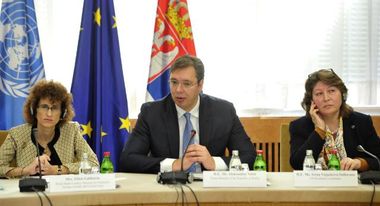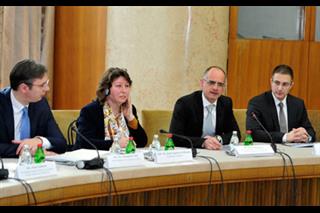search
search
Belgrade, March 4 – Government Office for Reconstruction and Flood Relief has today, in the presence of Prime Minister Aleksandar Vučić, as well as representatives of international institutions, EU, the diplomatic corps and the countries which have provided assistance to Serbia following the catastrophic floods, presented the National Disaster Risk Management Program.
The goal of the National Program is building an adequate long-term system of natural disaster risk management in the country, which would entail the cooperation of different institutions working together towards minimizing risks and a more efficient response to natural disasters.
The Prime Minister of Serbia Aleksandar Vučić has pointed out that, when it comes to natural disasters, the Government is decidedly dedicated to working, more than before, on preventive measures, and thus securing a different and safer future for generations to come. Serbia wishes to think ahead and plan ahead, the Prime Minister has emphasized, citing the fact that each dinar invested in prevention equals seven dinars spent on reconstruction. In his words, Serbia has annually been losing 130 million euros on account of floods, even more than that on account of droughts, and last year the catastrophic floods cost 1.7 billion euros.

“Prudent and serious behavior would allow us to view matters differently and enable us to always – at least to a degree – foresee the damage. Serbia is for the first time abandoning the “happy-go-lucky” principle and adopting the principle that “a stitch in time saves nine” for the decades that are upon us”, Vučić has emphasized.
The director of the Office for Reconstruction and Flood Relief Marko Blagojević, while presenting the program, pointed out to those present that it consisted of six component parts, of which the first is the building and developing of institutions. This is, in his words, step number zero, and the step that will permeate all other components.
The second component is identifying and monitoring risks of natural disasters, which encompasses the creation of flood maps. This will prepare us for the next time a flood takes place, by equipping us with the knowledge of the way in which the flooding will occur.
The Program stipulates an early warning system. Both structural and non-structural measures will be attended to in the Program, because, as he added, it must be seen to which extent it is necessary to change the existing local practices.
Blagojević pointed out that it is necessary to actively work on prevention in the sense of securing investments for new infrastructural projects of protection against flooding, landslides and other natural threats.
The Program, which will at first be directed by the Office, as he stressed, was created in cooperation with the best experts in the world.
 “For the first time, we want to tackle prevention. A great deal of resources has been invested precisely into the reconstruction of protective infrastructure. New mechanisms and new infrastructure are both needed”, he accentuated, adding that it is essential that we have at least one systemic approach, so that we can understand the risks that we are exposed to.
“For the first time, we want to tackle prevention. A great deal of resources has been invested precisely into the reconstruction of protective infrastructure. New mechanisms and new infrastructure are both needed”, he accentuated, adding that it is essential that we have at least one systemic approach, so that we can understand the risks that we are exposed to.
”We must have a high-resolution image of all the risks that Serbia and its population are exposed to”, Blagojević emphasized, adding that consolidating prevention entails a good understanding and a thorough knowledge of risks.
He pointed out that last year’s floods prompted a demonstration of solidarity in action, that aid poured in from all sides, and that the work could not have been completed without the donors who contributed to the fact that reconstruction is at an advanced stage and that we are now able to deal with prevention.
Prevention necessitates that institutions doing their job should be seamlessly combined into a single system, Blagojević said.
The floods that occurred in May were not the only ones we experienced in the previous year, he reminded those present, adding that few months had passed during the year 2014 in which at least one part of the country was not affected with floods. During the summer we even had a tornado in Lazarevac, and yesterday an earthquake as well, Blagojević recalled, adding that the annual damages caused by floods to Serbia amount to an average of 130 million euros.
At the same time, he drew attention to the fact that droughts cause a damage of 500 million euros to Serbia annually, which makes them, in comparison to floods, an enormous loss, but also that both droughts and floods should be viewed in an integrated manner, and approach them thus in the application of the Program.
The Swiss Ambassador Jean-Daniel Ruch pointed out that the world is, owing to climatic changes, with increasing frequency faced with natural disasters, and that this will continue to happen in the future as well. In his words, there were 39 major floods in the world in the year 1980, whereas in 2011 there were, according to the UN report, more than 150. Ruch remarked that this was the best indicator of the fact that the risk of flooding has increased exponentially in the last four decades.
”We have to be prepared for the years ahead of us. The best way to prepare is to have a coordinated approach, and the National Program is a good approach”, he stressed.
Ruch considers the fact that the mandate of the Office has been extended a good signal, and believes regional cooperation is of the essence.
Head of EU Delegation in Serbia Michael Davenport said that last year’s floods demonstrated that flooding knows no borders. Prevention of disasters, in his words, can effectively be realized only at the regional level – but also the continental and global levels.
Climate change, as he said, requires massive international efforts, and the EU as well as its individual member states have a significant responsibility in risk prevention. He was in agreement with Prime Minister Vučić’s assertion that every dinar invested in prevention was worth seven dinars in dealing with the consequences.
Davenport pointed out that the EU had a rulebook for the prevention of natural disasters, and that this particular area was the focus of IPA 14 funds.
UN Coordinator in Serbia Irena Vojáčková-Sollorano drew attention to the key highlights that describe the new mode of thought with regard to facing floods. The first one was that they represented a country’s developmental issue, as a disaster could annihilate the work of several decades and development must be considered to be jeopardized at such a moment.
Climate change is more than merely a new risk factor – it is a game-changer, she believes.
The Government has to be a key factor in the prevention and risk management of natural disasters, Vojáčková-Sollorano pointed out, adding that long-term thinking and securing the necessary funding were required.
She lauded the Prime Minister and the Government of Serbia for working towards a fast, efficient, and transparent recovery from the floods. Promising that she would offer assistance to the Serbian Government and that the presentation of the Program was only a first step towards this, she concluded her exposition with the message that Serbia can count on the UN to help.
World Bank Director for Southeastern Europe, Europe, and Central Asia Ellen Goldstein spoke admiringly of all that Serbia has done in damage reparation after last year’s natural disasters. She made the assessment that the National Program was a very important step in the prevention of future disasters.
As she declared, it will facilitate even better coordination between the Government and its agencies, as well as every other subject participating in these processes.